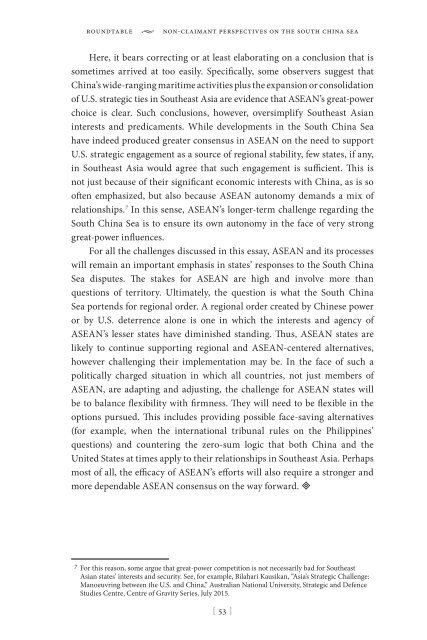You also want an ePaper? Increase the reach of your titles
YUMPU automatically turns print PDFs into web optimized ePapers that Google loves.
oundtable • non-claimant perspectives on the south china sea<br />
Here, it bears correcting or at least elaborating on a conclusion that is<br />
sometimes arrived at too easily. Specifically, some observers suggest that<br />
China’s wide-ranging maritime activities plus the expansion or consolidation<br />
of U.S. strategic ties in Southeast Asia are evidence that ASEAN’s great-power<br />
choice is clear. Such conclusions, however, oversimplify Southeast Asian<br />
interests and predicaments. While developments in the South China Sea<br />
have indeed produced greater consensus in ASEAN on the need to support<br />
U.S. strategic engagement as a source of regional stability, few states, if any,<br />
in Southeast Asia would agree that such engagement is sufficient. This is<br />
not just because of their significant economic interests with China, as is so<br />
often emphasized, but also because ASEAN autonomy demands a mix of<br />
relationships. 7 In this sense, ASEAN’s longer-term challenge regarding the<br />
South China Sea is to ensure its own autonomy in the face of very strong<br />
great-power influences.<br />
For all the challenges discussed in this essay, ASEAN and its processes<br />
will remain an important emphasis in states’ responses to the South China<br />
Sea disputes. The stakes for ASEAN are high and involve more than<br />
questions of territory. Ultimately, the question is what the South China<br />
Sea portends for regional order. A regional order created by Chinese power<br />
or by U.S. deterrence alone is one in which the interests and agency of<br />
ASEAN’s lesser states have diminished standing. Thus, ASEAN states are<br />
likely to continue supporting regional and ASEAN-centered alternatives,<br />
however challenging their implementation may be. In the face of such a<br />
politically charged situation in which all countries, not just members of<br />
ASEAN, are adapting and adjusting, the challenge for ASEAN states will<br />
be to balance flexibility with firmness. They will need to be flexible in the<br />
options pursued. This includes providing possible face-saving alternatives<br />
(for example, when the international tribunal rules on the Philippines’<br />
questions) and countering the zero-sum logic that both China and the<br />
United States at times apply to their relationships in Southeast Asia. Perhaps<br />
most of all, the efficacy of ASEAN’s efforts will also require a stronger and<br />
more dependable ASEAN consensus on the way forward. <br />
7 For this reason, some argue that great-power competition is not necessarily bad for Southeast<br />
Asian states’ interests and security. See, for example, Bilahari Kausikan, “Asia’s Strategic Challenge:<br />
Manoeuvring between the U.S. and China,” Australian National University, Strategic and Defence<br />
Studies Centre, Centre of Gravity Series, July 2015.<br />
[ 53 ]


